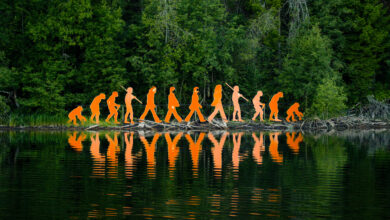
10 Unbelievable Theories of Why We Dream
We spend an impressive part of our lives sleeping and dreaming, but scientists still can’t quite fathom why we do it. And it’s not always that we get to see dreams, but when we do, they are usually about some random things and parts from our daily lives. While some scientists believe that dreams don’t mean anything in particular and don’t have any impact on us whatsoever, others tend to disagree with them and study not only the causes of dreams, but also the meanings behind them for each person. So why do we dream? Here are 10 theories that might shed some light on the matter.
Dream Moods A-Z Dream Dictionary

Memory storage
Numerous studies reveal that during sleep our brains work with memories quite a lot. Some of them get transferred into long-term memory storage, while others get processed and are taken to different parts of the brain. New information goes from the hippocampus to the cerebral cortex that is responsible for processing everything new and turning it into actual knowledge.
Therapy
Dreaming can be quite a therapeutic experience if you have some unresolved issues or feelings you need to sort out. Whether it’s something that happened recently or a childhood trauma from decades ago, dreams can help you get to the bottom of things because while sleeping your brain works in a different way and can give you a new perspective on things. Some researchers believe that dreams are a safe haven where one can face his deepest fears and solve various problems.

Anxiety prevention
A 2009 research studied two groups of people – healthy ones and those with anxiety and depression. It turned out that people who had anxiety were dreaming about self-victimization and aggression more often than the healthy people. This means that REM sleep may actually help patients to deal with their emotions of sadness, low self-esteem, and anger.

Health
It’s a well-known fact that sleep deprivation can literally kill your health for good. No wonder it was used as a torture technique by so many people! Researchers found out that people who weren’t allowed to dream (they were woken up right at the beginning of REM sleep) experienced lack of coordination, increased tension, and even weight gain!

Lack of dreams is a bad sign
There’s a link between psychiatric disorders and sleep issues. Around 80% of people that have been diagnosed with mental disorders were also having problems sleeping (and dreaming, for that matter). This means that there’s a good chance that by treating sleep issues we will also prevent the development of mental disorders.

Information processing theory
REM sleep has another very important function. It is during the REM sleep that our brain processes new information and links it to the existing knowledge we have about the world. Related concepts are connected to the newly received facts and are later integrated into our overall understanding of the world. While being at it, our brain tries to create a narrative to help this erratic process to go as smooth as possible. And that’s how dreams appear!

Psychoanalysis
We can’t talk about dreams and skip the almighty Sigmund Freud now, can we? The father of psychoanalysis has had plenty of wild ideas and while some of them have been disproved over the course of history, others are still quite interesting to think about. Freud believed that our subconscious mind is talking to us via dreams. This means that interpreting dreams is something every person should do on a daily basis! He thought that our dreams express all that is suppressed during the day, all those dark desires and unacceptable ideas that can’t be revealed to the public. By acknowledging them and dealing with the new-found issues people can become much healthier and, as a result, happier.

Activation-synthesis model
According to this theory, dreams are a mere biological response to the activation of some parts of our brain, like the amygdala that is responsible for emotions. This means that our brain simply creates dreams as a reaction to signals, not the memories or experiences we’ve had during the day. The authors of this theory, however, do not consider dreams meaningless – they believe that those dreams lead to the birth of new ideas.

Adaptive theory
According to the adaptive theory, what we now call sleep is a mechanism used by animals to stay out of harm’s way. They find a safe location to get some sleep and, as a result, avoid getting hurt. Another part of this theory states that REM sleep (basically, dreaming) is also an essential part of our survival. It turns out that animals who do not get enough REM sleep, tend to sleep more the next time they rest (it’s called REM rebound). This means that REM sleep is an important biological function and animals (well, humans as well) should get enough of it in order to go on with our lives and avoid trouble. Evolution has weeded out those species that weren’t getting enough of it and couldn’t adequately adapt to the ever-changing surroundings.

Threat stimulation theory
Dreams also allow us to rehearse various threatening situations and develop proper reactions to those threats. Researchers have studied the dreams of children from threatening and non-threatening households and found out that children who lived in a bad environment had wild scary dreams, whereas children from healthy families had calmer dreams and their ‘threat simulation system’ was hardly activated.

14 Common Dreams and What They Really Mean
The Secret Meaning of 60 Common Dreams, According to Experts




